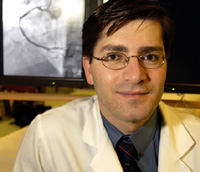Shortness of breath climbing stairs or walking down the street, nausea, a tightness or pain in the chest, perhaps extending down the left arm: It's a scary scenario and likely the symptoms of a heart attack caused by a narrowing of the arteries due to atherosclerosis.
Patients now have a number of choices for treating their underlying coronary artery disease (blockages in the heart arteries): inserting tiny mesh devices called stents, getting coronary artery bypass graft surgery, or simply getting drug treatment and monitoring the problem.
Picking the right path for treatment requires the combined knowledge of many experts who know the strengths and weaknesses of each approach, UCSF heart doctors say.
 |
Yerem Yeghiazarians |
"You have to have a close, working relationship between the primary care doctor, the heart surgeons, the cardiologists and others," says Yerem Yeghiazarians, MD, an interventional cardiologist in the UCSF Heart and Vascular Center at UCSF Medical Center and assistant clinical professor of cardiology. "Most important, we need to educate and inform our patients of the treatment options and together make the best decision in each case."
The UCSF Heart and Vascular Center brings together cardiologists, cardiac and vascular surgeons, interventional radiologists and other specialists to provide the most advanced and effective treatments, many of them developed at UCSF Medical Center.
Atherosclerosis is the formation of a hard plaque along the blood vessel walls. This narrows the vessel and hinders blood flow. This is very dangerous in the coronary arteries, the crown of vessels that circle the heart and bring oxygen to the heart itself. If the coronary arteries become narrow enough, the oxygen-starved heart begins to hurt. If the coronary arteries are blocked, the heart muscle begins to die.
Sometimes, medications can be used to hinder plaque formation and bust up clots that may block the narrowed arteries. But many patients eventually need direct intervention to clear up the problem.
Bypass Surgery
Coronary artery bypass graft surgery is the most established solution for blockages or narrowing in the coronary arteries. The technique was developed in the 1960s and has remained fundamentally the same. Arteries or veins from elsewhere in the body are grafted to the coronary arteries on each side of the atherosclerotic narrowing, thus giving blood a path to "bypass" the blockage.
 |
Scot Merrick |
The terms
single bypass,
double bypass,
triple bypass, etc. refer to the number of coronary arteries that are replaced during the procedure. The procedure is done during open heart surgery - meaning that the chest is opened up to provide surgeons direct access to the heart. Often the heart is stopped during the surgery and the patient's blood is circulated through a heart bypass machine.
One of the main benefits is that this procedure is well-established. "The procedure has been so intensively studied over the years that we have gotten over the hurdle of learning who should get these and when," says UCSF cardiac surgeon Scot Merrick, MD. Patients often experience complete relief of symptoms, and the bypasses last for years.
The drawbacks of the procedure are that it requires open heart surgery. Recovery from the procedure can be painful and require multiple days in the hospital.
Stents
In the 1980s, a new technique arose that promised to revolutionize the process of opening coronary arteries. Through a small incision in the thigh, interventional cardiologists learned to thread a narrow, wire-like catheter up into the coronary vessels, where a balloon is inflated to widen the atherosclerotic blood vessels.
The problem is that arteries opened in this way tend to contract again over time. So cardiologists started inserting a stent: a fine, mesh cage that can expand inside the artery and hold it open. In the last few years, they have routinely begun using stents that release drugs to help keep the artery open.
"Percutaneous coronary interventions have advanced tremendously over the last decade and have changed the field of interventional cardiology," says Yeghiazarians. "It has been shown that angioplasty works better than just the clot-busting medications in the setting of a heart attack. To treat the heart blockages in patients not in the midst of a heart attack, there are often options of medical therapy, angioplasty, stenting or consideration of bypass surgery."
But don't expect coronary bypass procedures to become a thing of the past. When former President Bill Clinton was recently diagnosed with significant blockages of his coronary arteries, he opted for a quadruple bypass surgery rather than stents.
"When I was a medical student in 1974, I heard about research in stents and asked my adviser if I should study heart surgery," Merrick says. "My adviser told me there would always be a need for good heart surgeons."
All agree that the key to picking the best therapy is to get the best heart surgeons, vascular surgeons and cardiologists together to evaluate the individual features of each case. "All options may have a role," Yeghiazarians says. "The therapy has to be individualized to the patient.
"No matter what therapy you get, you still need to pay attention to exercise, diet, smoking cessation, weight, and alcohol and drug consumption. These things are at the base of good health."
Photos by Christine Jegan
Related Links:
UCSF Medical Center





